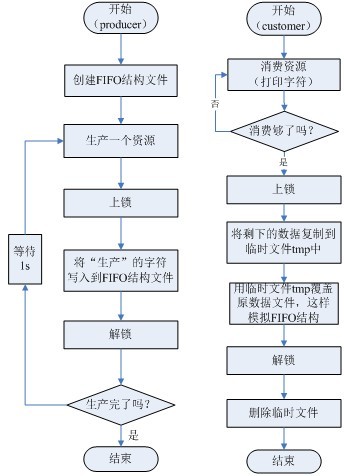|
1.实验目的
通过编写文件读写及上锁的程序,进一步熟悉Linux中文件I/O相关的应用开发,并且熟练掌握open()、read()、write()、fcntl()等函数的使用。
2.实验内容
在Linux中FIFO是一种进程间的管道通信机制,Linux支持完整的FIFO通信机制。
本实验内容比较有趣,我们通过使用文件操作,仿真FIFO(先进先出)结构及生产者—消费者运行模型。
本实验中需要打开两个虚拟终端,分别运行生产者程序(producer)和消费者程序(customer),此时两个进程同时对同一个文件进行读写操作。因为这个文件是临界资源,所以可以使用文件锁机制来保证两个进程对文件的访问都是原子操作。
先启动生产者进程,它负责创建仿真FIFO结构的文件(其实是一个普通文件)并投入生产,就是按照给定的时间间隔,向FIFO文件写入自动生成的字符(在程序中用宏定义选择使用数字还是使用英文字符),生产周期及要生产的资源数通过参数传递给进程(默认生产周期为1s,要生产的资源总数为10个字符,显然默认生产总时间为10s)。
后启动的消费者进程按照给定的数目进行消费,首先从文件中读取相应数目的字符并在屏幕上显示,然后从文件中删除刚才消费过的数据。为了仿真FIFO结构,此时需要使用两次复制来实现文件内容的偏移。每次消费的资源数通过参数传递给进程,默认值为10个字符。
3.实验步骤
(1)画出实验流程图。
本实验的两个程序的流程图如图2.5所示。

图2.5 文件读写及上锁实验流程图
(2)编写代码。
本实验中的生产者程序的源代码如下所示,其中用到的lock_set()函数可参见后面章节。
/* producer.c */
#include <stdio.h>
#include <unistd.h>
#include <stdlib.h>
#include <string.h>
#include <fcntl.h>
#include "mylock.h"
#define MAXLEN 10 /* 缓冲区大小大值 */
#define ALPHABET 1 /* 表示使用英文字符 */
#define ALPHABET_START 'a' /* 头一个字符,可以用 'A' */
#define COUNT_OF_ALPHABET 26 /* 字母字符的个数 */
#define DIGIT 2 /* 表示使用数字字符 */
#define DIGIT_START '0' /* 头一个字符 */
#define COUNT_OF_DIGIT 10 /* 数字字符的个数 */
#define SIGN_TYPE ALPHABET /* 本实例选用英文字符 */
const char *fifo_file = "./myfifo";/* 仿真FIFO文件名 */
char buff[MAXLEN]; /* 缓冲区 */
/* 功能:生产一个字符并写入到仿真FIFO文件中 */
int product(void)
{
int fd;
unsigned int sign_type, sign_start, sign_count, size;
static unsigned int counter = 0;
/* 打开仿真FIFO文件 */
if ((fd = open(fifo_file, O_CREAT|O_RDWR|O_APPEND, 0644)) < 0)
{
printf("Open fifo file error\n");
exit(1);
}
sign_type = SIGN_TYPE;
switch(sign_type)
{
case ALPHABET:/* 英文字符 */
{
sign_start = ALPHABET_START;
sign_count = COUNT_OF_ALPHABET;
}
break;
case DIGIT:/* 数字字符 */
{
sign_start = DIGIT_START;
sign_count = COUNT_OF_DIGIT;
}
break;
default:
{
return -1;
}
}/*end of switch*/
sprintf(buff, "%c", (sign_start + counter));
counter = (counter + 1) % sign_count;
lock_set(fd, F_WRLCK); /* 上写锁 */
if ((size = write(fd, buff, strlen(buff))) < 0)
{
printf("Producer: write error\n");
return -1;
}
lock_set(fd, F_UNLCK); /* 解锁 */
close(fd);
return 0;
}
int main(int argc ,char *argv[])
{
int time_step = 1; /* 生产周期 */
int time_life = 10; /* 需要生产的资源总数 */
if (argc > 1)
{/* 第一个参数表示生产周期 */
sscanf(argv[1], "%d", &time_step);
}
if (argc > 2)
{/* 第二个参数表示需要生产的资源数 */
sscanf(argv[2], "%d", &time_life);
}
while (time_life--)
{
if (product() < 0)
{
break;
}
sleep(time_step);
}
exit(EXIT_SUCCESS);
}
本实验中的消费者程序的源代码如下所示:
/* customer.c */
#include <stdio.h>
#include <unistd.h>
#include <stdlib.h>
#include <fcntl.h>
#define MAX_FILE_SIZE 100 * 1024 * 1024 /* 100M */
const char *fifo_file = "./myfifo"; /* 仿真FIFO文件名 */
const char *tmp_file = "./tmp"; /* 临时文件名 */
/* 资源消费函数 */
int customing(const char *myfifo, int need)
{
int fd;
char buff;
int counter = 0;
if ((fd = open(myfifo, O_RDONLY)) < 0)
{
printf("Function customing error\n");
return -1;
}
printf("Enjoy:");
lseek(fd, SEEK_SET, 0);
while (counter < need)
{
while ((read(fd, &buff, 1) == 1) && (counter < need))
{
fputc(buff, stdout); /* 消费就是在屏幕上简单的显示 */
counter++;
}
}
fputs("\n", stdout);
close(fd);
return 0;
}
/* 功能:从sour_file文件的offset偏移处开始,
将count字节数据复制到dest_file文件 */
int myfilecopy(const char *sour_file,
const char *dest_file, int offset, int count, int copy_mode)
{
int in_file, out_file;
int counter = 0;
char buff_unit;
if ((in_file = open(sour_file, O_RDONLY|O_NONBLOCK)) < 0)
{
printf("Function myfilecopy error in source file\n");
return -1;
}
if ((out_file = open(dest_file, O_CREAT|O_RDWR|O_TRUNC|O_NONBLOCK, 0644)) < 0)
{
printf("Function myfilecopy error in destination file:");
return -1;
}
lseek(in_file, offset, SEEK_SET);
while ((read(in_file, &buff_unit, 1) == 1) && (counter < count))
{
write(out_file, &buff_unit, 1);
counter++;
}
close(in_file);
close(out_file);
return 0;
}
/* 功能:实现FIFO消费者 */
int custom(int need)
{
int fd;
/* 对资源进行消费,need表示该消费的资源数目 */
customing(fifo_file, need);
if ((fd = open(fifo_file, O_RDWR)) < 0)
{
printf("Function myfilecopy error in source_file:");
return -1;
}
/* 为了模拟FIFO结构,对整个文件内容进行平行移动 */
lock_set(fd, F_WRLCK);
myfilecopy(fifo_file, tmp_file, need, MAX_FILE_SIZE, 0);
myfilecopy(tmp_file, fifo_file, 0, MAX_FILE_SIZE, 0);
lock_set(fd, F_UNLCK);
unlink(tmp_file);
close(fd);
return 0;
}
int main(int argc ,char *argv[])
{
int customer_capacity = 10;
if (argc > 1) /* 第一个参数指定需要消费的资源数目,默认值为10 */
{
sscanf(argv[1], "%d", &customer_capacity);
}
if (customer_capacity > 0)
{
custom(customer_capacity);
}
exit(EXIT_SUCCESS);
}
(3)先在宿主机上编译该程序,如下所示:
$ make clean; make
(4)在确保没有编译错误后,交叉编译该程序,此时需要修改Makefile中的变量。
CC = arm-linux-gcc /* 修改Makefile中的编译器 */
$ make clean; make
(5)将生成的可执行程序下载到目标板上运行。
4.实验结果
此实验在目标板上的运行结果如下所示。实验结果会和这两个进程运行的具体过程相关,希望读者能具体分析每种情况,下面列出其中一种情况。
终端一:
$ ./producer 1 20 /* 生产周期为1s,需要生产的资源总数为20个 */
Write lock set by 21867
Release lock by 21867
Write lock set by 21867
Release lock by 21867
…
终端二:
$ ./customer 5 /* 需要消费的资源数为5个 */
Enjoy:abcde /* 对资源进行消费,即打印到屏幕上 */
Write lock set by 21872 /* 为了仿真FIFO结构,进行两次复制 */
Release lock by 21872
在两个进程结束后,仿真FIFO文件的内容如下:
$ cat myfifo
fghijklmnopqr /* a到e的5个字符已经被消费,就剩下后面15个字符 */
本文选自华清远见嵌入式培训教材《从实践中学嵌入式Linux应用程序开发》
热点链接:
1、linux 文件锁的实现及其应用
2、嵌入式Linux串口应用编程之串口读写
3、Linux文件系统之虚拟文件系统
4、标准I/O操作函数详解
5、标准I/O操作的缓冲存储类型
更多新闻>> |

